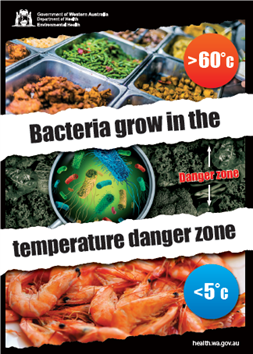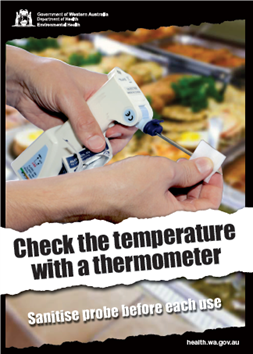What are potentially hazardous foods?
Under the Food Standards Code, potentially hazardous food is defined as food that has to be kept at certain temperatures to:
- minimise the growth of any pathogenic micro-organisms that may be present in the food
- prevent the formation of toxins in food.
Examples of potentially hazardous foods include:
- food containing raw and cooked meats including casseroles, pies and sandwiches
- dairy products and processed foods containing eggs, beans and nuts
- seafood
- processed fruits and salads such as pre-prepared salads and ready to eat fruit packs
- cooked rice and pasta.
What is a safe temperature?
 Safe temperatures are 5 °C or colder, or 60 °C or hotter.
Safe temperatures are 5 °C or colder, or 60 °C or hotter.
Potentially hazardous foods need to be kept at these temperatures to prevent any food-poisoning bacteria, which may be present in the food, from multiplying to dangerous levels.
You can also use time, rather than temperature to keep food safe. This is known as the 2 hour/4 hour guide. You must keep records if using this method.
The 2 hour/4 hour guide
Potentially hazardous foods should be kept at 5 °C or colder or above 60 °C wherever possible, however ready-to-eat foods can safely remain between 5 °C and 60 °C for up to 4 hours.
This is because it takes more than 4 hours for food poisoning bacteria to grow to dangerous levels.
The 2 hour/4 hour guide only applies to ready-to-eat and potentially hazardous foods. The time refers to the life of the food, including preparation and cooling, not just to display times. When using the guide, please remember to use the total time.
Table: The 2 hour/4 hour guide
| Total time limit between 5 °C and 60 °C |
What you should do |
| Less than 2 hours |
Refrigerate or use immediately |
| Between 2 hours and 4 hours |
Use immediately |
| More than 4 hours |
Throw out |
Thermometers
 Every food premises that prepares, handles or sells any potentially hazardous food must have a thermometer to ensure food is kept at safe temperatures. The thermometer must be accurate to ±1 °C.
Every food premises that prepares, handles or sells any potentially hazardous food must have a thermometer to ensure food is kept at safe temperatures. The thermometer must be accurate to ±1 °C.
Remember the temperature at the centre of the food may be different to the surface temperature, therefore when checking the temperature make sure you check the centre of the food.
How do I use the thermometer to measure the temperature of food?
- Before use, ensure the thermometer is clean and dry. If using a probe thermometer, ensure the probe has been sanitised.
- Place the probe into the food and wait until the temperature reading has stabilised before reading.
- Measure different parts of a food as the temperature may not be the same in all parts. For example, if food is being cooled in a refrigerator, the top of the food may be cooler than the middle of the food.
- Clean and sanitise the thermometer after measuring the temperature of one food and before you measure the temperature of another food.
- If using the thermometer to measure hot and cold food, wait for the thermometer to return to room temperature between measurements.
- Measure the temperature of different foods in a refrigerator or display unit as there will be colder and hotter spots within the refrigerator or unit.
- Measure the temperature of packaged chilled food by placing the length of the thermometer between two packages – the temperature will be approximate but the package remains intact.
How do I clean and sanitise a thermometer?
As the thermometer probe will be inserted into food, it must be cleaned and sanitised before it is inserted into different food.
If the probe is not cleaned and sanitised, food poisoning bacteria may be transferred from one food to another. For example if the thermometer is used to measure the temperature of raw food and then cooked food, such as a raw hamburger patty and then a cooked hamburger patty.
The probe of a thermometer can be cleaned and sanitised using these steps:
- Wash the probe with warm water and detergent.
- Sanitise the probe appropriately (alcohol swabs can be used).
- Rinse the sanitiser away if necessary (refer to the instructions on the sanitiser).
- Allow the probe to air dry or thoroughly dry it with a disposable towel.
Maintaining a thermometer
You need to maintain the thermometer in good working order. This means replacing the batteries if they are flat or repairing the thermometer if it breaks.
You will also need to maintain the accuracy of the thermometer. This means that you should make sure it is calibrated correctly on a regular basis.
More information
Contact the Environmental Health Services at your local government (external site).
Last reviewed: 11-11-2020
Produced by
Environmental Health Directorate